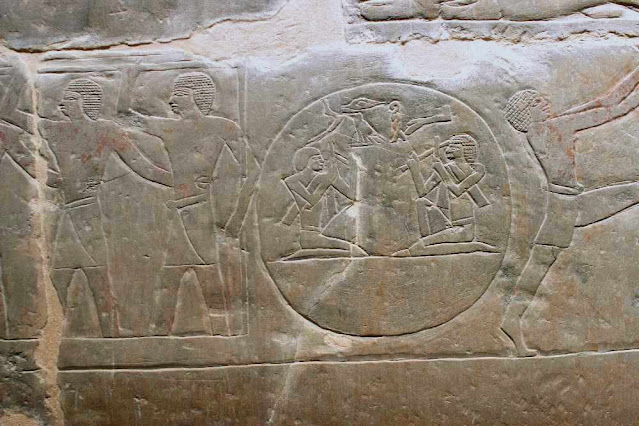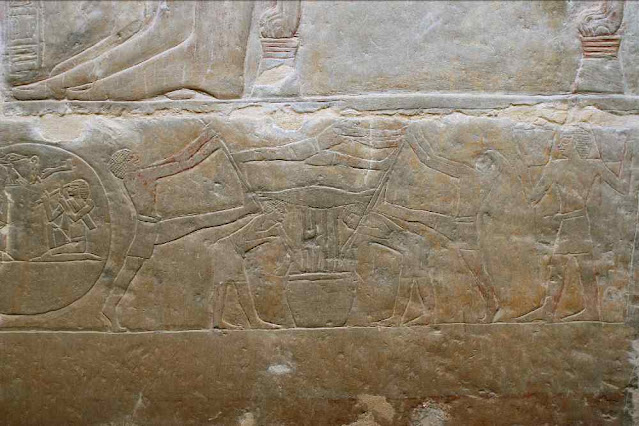register 1 - four individuals pulling a rope-drawn sledge laden with four very large jars. The scene is described in the text above them. It reads: "A boon which the king gives, a boon which Anubis gives, thousand of all (sorts of) ointments for T, N".
- register 2 - two large chests are transported on poles by by four men. Again, the scene is described in the text above them, of which very little now exists.
In front of them, the wall is occupied by processions of servants transporting various goods towards Mereruka (see ww-2) :
In the bottom register :
- three men, each carry two bands of material.
- seven men follow holding the vases of various shapes, all containing oils.
- The remains (due to the ancient damage) of four chests, each being carried on poles by two men.
The scene is described in the text above them, the latter part of which is missing. It reads: "Bringing the first class royal linen and clothing, the first class ointments, which are given to him from the residence as a boon which the king gives to T, N".
Second register :
- four large chests are carried on poles by eight men.
- the following decoration is missing.
Only the beginning of the descriptive text has survived. It reads: "A boon which the king gives, a boon which Anubis gives, thousand of all (sorts of) ointments for T, N".
Third register :
- servants carry tables on which the contents have not survived, towards at least one standing table containing three vessels.
register 1 - a stand with three large spouted vessels, then three men pulling a sledge on which are three more large containers. The last vessel is steadied by a man at the rear. The scene is described in the text above them: "A boon which the king gives, a boon which Anubis gives, thousand of all (sorts of) ointments for T, N".
- register 2 - two large chests are transported on poles by four men. Again, the scene is described in the text above them: "Bringing the best clothing (…) T, N".
- register 3 - three tables on which stand, in apparently exaggerated size, two necklaces on the middle one and a pectoral on the two outer ones.
The remainder, southern half of the wall, is occupied by processions of servants transporting various goods towards Mereruka :
In the bottom register :
- three men, each bringing two bands of material.
- seven people holding the vases containing oils.
- four chests are each being carried on poles by two men.
The text above them says: "Bringing the first class royal linen and clothing, the first class ointments, which are given to him from the residence as a boon which the king gives to T, N".
Second register :
- four large chests are carried on poles by eight men.
- five servants follow them, each holding a large spouted vessel.
- at the rear, five more follow carrying long narrow vessels.
The text above says: " (A boon which the king gives ?), a boon which Anubis gives a thousand of cloth to T, N".
Third register :
- servants carry eight tables on which are placed necklaces and other ornaments, towards two tables which have already been placed down. Nothing much remains of the descriptive text.
Mereruka is seated with his wife squatting in front of him, breathing the perfume of a lotus flower. Mereruka reaches out with his right hand as if to accept the items from the porters. The columns of text above him are very incomplete, but, directly in front of him is an unbordered list of these goods. They are listed in "thousands" of : breads, beer, meat, cloths, etc.
The column of text in front of Mereruka says: "Observing the sweet offerings, which are brought to him as a boon which the king gives, for the honoured one by Osiris, Meri".
Below the couple is a continuation of the lowest register of those in front of them
In the lowest register is shown the manufacture of wine. From the left, four men arrive carrying small baskets full of grapes. The bunches are placed in a vat, and six men holding onto a beam tread the fruit (
. In a circular construct, two stone masons prepare a vat Mereruka a). They form it with chisels, to give it a round shape.
Finally the fruit is placed in a bag and stretched between two long poles. When the bag is twisted by the two operatives, the mash is pressed and juice flows out through the cloth
. Another porter at the right-hand side of the register also appears to be carrying more baskets of grapes to be processed.
In the second register, ten granaries have been constructed next to each other; each have arched roofs. Men measure the product of the harvest from fruit trees. These are sycamore figs, red fruits, normal figs and carobs. A scribe takes note of the results. Other people carry away the fruit.
The third register shows two sledges each carrying three tall cases, each drawn by three men, and accompanied in front by a scribe carrying his palette.
The remaining upper part of the wall represents offerings of all kinds, among which are cuts of meat.
The east wall :
On the left, but above the bottom register and occupying the height of the remaining registers, Mereruka (facing south) receives the servants displayed at the beginning of each facing register. They each bring him a vase containing perfumes or oils and stand in front of other offerings.
In the lowest register (this being the one which extends under Mereruka) are represented some butchered animals, with their fore-limbs separated and placed on top of the bound carcasses.
(
Mereruka a)
- in the 2nd register are at eight vases in two crates. The text in front of the servant says:
"The best Libyan oil for Mereruka, for his ka, daily".
- in the 3rd are five individuals holding two strips of cloth. The servant's text says:
"The best cedar oil for Mereruka, for his ka, daily".
(
Mereruka a)
- in the 4th there are two chests full of incense and colour pigment. The servant's text says:
"twAwt-oil for Mereruka, for his ka, daily". Whilst above the first box:
"A box containing incense"and the second box:
"A box containing kohl"(powdered antimony, for darkening the eyelids).
- in the 5th a further five servants bring more offering vases. The servant's text says:
"nXnm-oil for Mereruka, for his ka, daily".
The south wal
Mereruka is seated on the left facing west, his wife is again squatting in front of him.
As with the east wall, the lowest register passes beneath the seated Mereruka and again it displays butchered animals. At the right-hand end of the register are two servants who present these offerings.
- in the 2nd, ten servants carrying products of all kinds.
- in the 3rd, a servant presents an offering, followed by a chest then vases in crates.
- in the 4th, ten more servants carrying offerings.
- and finally, at the top, two registers of a variety of heaped offerings.
of the right end of the wall, and south entrance wall view.












Comments
Post a Comment